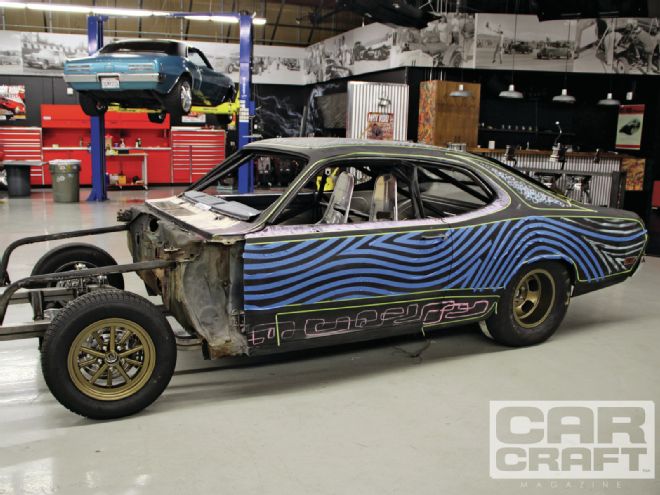
“Before getting started, the vehicle must be 100 percent complete.” That is the first line in the instructions for measuring the baseline spring rate on a Chris Alston’s drag race 2x3 A-arm suspension and frameclip. Not that we read directions, but this one seemed important, so we thought we’d mention it. What the guys at Chassisworks meant was the car must have everything installed, and it should be running, full of gas, and feature a driver behind the wheel before adjusting the suspension.
In the July ’11 issue, we welded such a frame kit onto our swap meet Demon to get the front end to work with the previously back-halved rear and to add some needed adjustability to the suspension. In the process, we gained total control over the shock rate and spring preload and the ability to place the engine almost anywhere in the chassis, and we dropped some pounds off the nose of the car. Since the car is not yet complete, we aren’t ready to turn any wrenches on shock collars or rod ends, but we can tell you what we’ve already gained, and more important, why.
Front Suspension Install - Weight Transfer
We are building this car purely for your entertainment (and ours) and therefore it will not be entered into any official racing class. That means we can run the car as light as we want. Racers who are constrained by rules also need to be as light as possible, allowing them to use any additional weight as ballast.
Without the engine and transmission, the Demon weighed about 1,850 pounds. After we cut the stock front end off and added the new 2x3 frame and a ’glass hood and deck, the car weighed about 1,550 pounds. That 300 pounds is worth 0.30 second at the track, and we haven’t even turned the key.
60-foot and R/T
Using a handicap or Sportsman Tree, the time between the last amber going dark and the start bulb going green is 0.500 second. Each hundredth of a second after that just adds humiliation. On a Pro Tree, the difference is only 0.400 second. Pro racers need to get out of the starting beam quickly, improving their reaction time, and get to the finish line first. To do this, a pro car will limit front suspension travel or adjust the spring rate and shock valving to yank the tire out of the beams. That combined with a violent motor and a light chassis will yield a fast but less consistent race car. For the dial-in racer, the reaction time needs to be combined with consistent e.t. for round wins. A driver can use rollout math to anticipate how long it takes for the tire to leave the beams instead of using violence, which will result in consistently faster times and more wins. The adjustable front suspension lets you pick how the car leaves the line.
Front Suspension Install - Shocks (Dampers) and Springs
Racing is trial and error. The difference between a monster wheelstand and porpoising all over the track is in the settings on the shocks and the rate of the springs. Without getting too far into the theory of a spring’s potential energy, we can tell you that preloading a spring will help lift the front end and transfer weight to the rear of the car quicker to improve the 60-foot time.
With this suspension system, spring rates can be easily be changed and springs can be preloaded at the track or shop using an endless number of available parts.
Front Suspension Install - Alignment
The primary concern on a drag car is to get the car to go straight and avoid scrubbing off speed. The standard alignment angles are 6 to 8 degrees of positive caster, zero degrees of camber, and 1⁄8 inch or less toe-in. The greater the amount of positive caster, the heavier the steering will feel, but it will add high-speed stability and help the steering self center. Neutral or negative caster will cause the steering to feel light and unstable at the top end of the track.
The camber setting has to do with the relationship of the top of tire to the bottom of the tire, as seen from the front of the car. In a road race car, there are modifications for camber gain that allow the contact patch to stay flat on a loaded tire in the corners. In a drag car, zero degrees ensures the tire stands up, and that is all you need.
A zero-degree toe setting at ride height will generally cause toe-out under acceleration depending on suspension travel, and it can cause high-speed instability. A 1⁄8-inch toe-in will ensure zero toe when you need it. These settings are the small but effective things that turn an average race car into a great one. You’re not going to get 8 degrees of caster out of a stock front end. It’s all about adjustability.
Front Suspension Install - What Next?
Installing the front suspension at this point is little more than creating a roller. The weight of the drivetrain is going have an effect on virtually everything going on in the chassis. Therefore, our next step is to work with the eBay Hemi to get it into the car with the transmission, then set the ride height and corner weights and go from there.
Parts List
Description Source PN Price Drag race A-arm suspension and frameclip Chassisworks PKG H $1,398.00 Coilover shocks Chassisworks 11211-280 658.00 Fabricated spindle Chassisworks 6165 479.00 Gasser ET wheels Speedway Motors 91058672 279.00 Indy slotted mags Internet N/A 30.00 (each) Pinto rack-and-pinion Chassisworks 6119 229.00